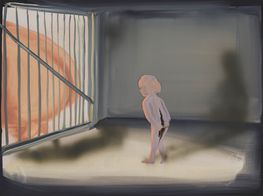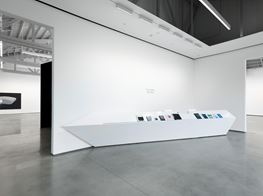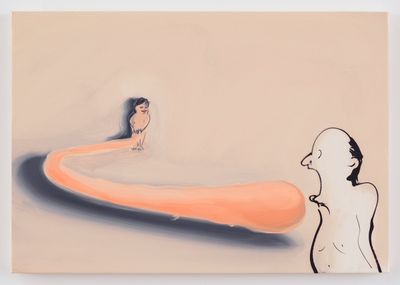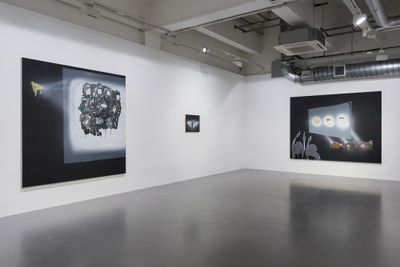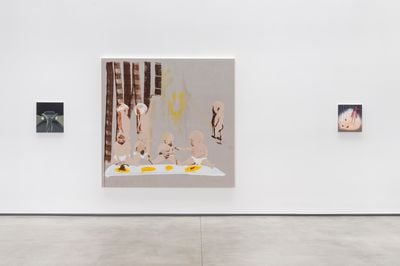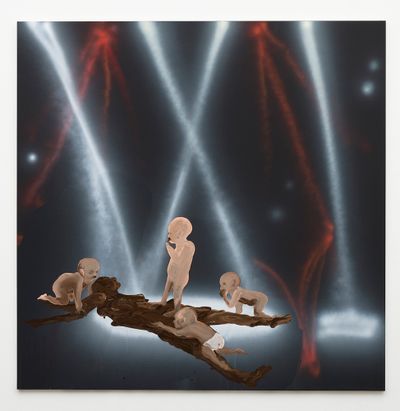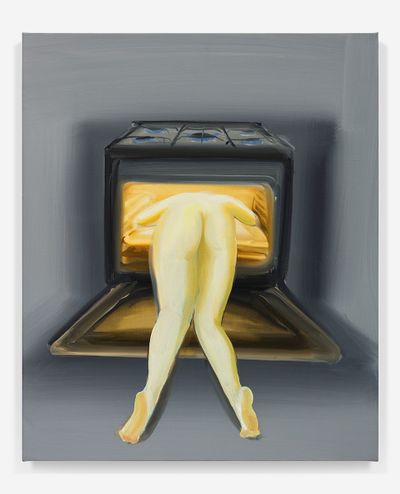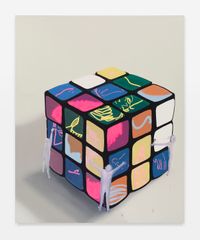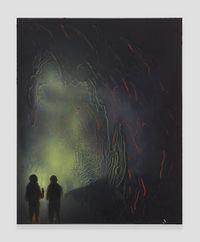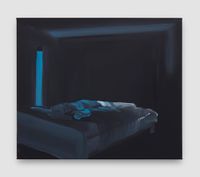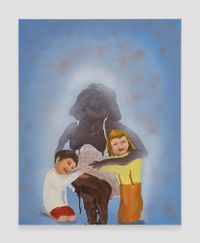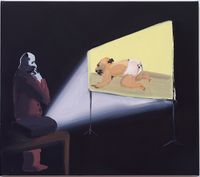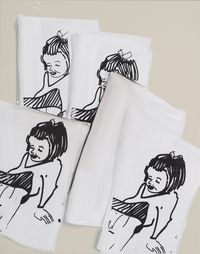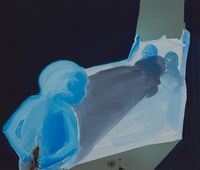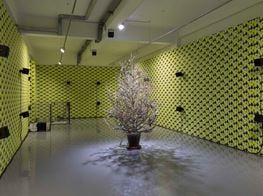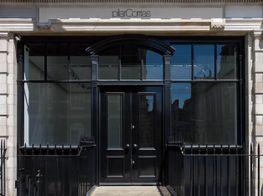Tala Madani: 'I don't make a conscious decision to subvert the gaze'
Tala Madani. Courtesy David Kordansky Gallery, Los Angeles. Photo: Jersey Walz.
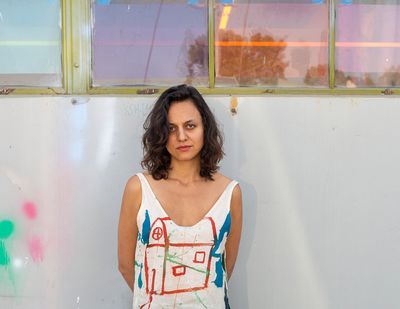
Tala Madani. Courtesy David Kordansky Gallery, Los Angeles. Photo: Jersey Walz.
Tehran-born, Los Angeles-based artist Tala Madani's paintings and animations fluctuate between comic strip, political satire, and abstraction in their depictions of human figures in their most primal states. Her paintings are characterised by thick and unfinished brushstrokes, which enable an immediacy as they lay bare absurd power systems in intimate portrayals that fuse the personal with the political.
Madani has become known for using humour as a way to comment on and consider the effects of hyper-masculine culture in contemporary society. Men are often naked and expelling or revelling in bodily fluids as they take part in chaotic acts of buffoonery such as pissing, shitting, or ejaculating; personal grooming and other male bonding sessions descend into scenes that are as sadistic as they are infantile.
In Men R Hot On Fire (2010), clumsy abstracted male figures spell out the title of the work by contorting their naked bodies into letters with the letter-man 'T' humorously engulfed in flames. O (2015), on the other hand, depicts a solitary male figure in awe of his exaggerated phallus.
Sources of natural and artificial light also appear in Madani's works, holding psychological and symbolic value, while using light and shadows to create space. In works that make up the 'Shitty Disco' series, shown between 5 October and 12 November 2016 at Pilar Corrias in London, figures in darkness project light from their anuses, while other paintings frame disco settings that have descended into chaos.
Madani's explorations of the qualities of light are most evident in her recent exhibition Oven Light, curated by Christina Lehnert at Portikus in Frankfurt (9 February–14 April 2019). The exhibition comprised a new series of paintings and animations depicting 'light itself as a medium—projected, brilliant, and radiant—and what its sweeping gaze might reveal.' The oven as a recurring motif featured prominently in this exhibition in works such as Oven lit nude (2018), presenting a glimpse of the darker aspects of domestic life as a body is rendered with its head in an oven illuminated by the orange hue of flames.
For her forthcoming solo exhibition at David Kordansky Gallery, Los Angeles (Shit Moms, 7 September–19 October 2019) taking place across all three of Kordansky's interconnected gallery spaces, Madani turns her attention to the figure of the mother and motherhood itself, explored through new paintings and animations. In the conversation that follows, Madani discusses a slight departure from using humour as a point of entry, the endless possibilities offered by light to address tensions in painting, and making difficult subjects more palatable.
JDYou have previously used humour as a way to tackle difficult subjects dealing with primal behaviour, non-conformism, and power dynamics. But recent paintings such as Oven lit nude (2018) are less humorous. Have you moved away from using humour as a central theme?
TMIn general, I am not using humour in the same way as I did in previous paintings and to some extent, laughter served as a side effect to a way of working. Humour and laughter, however, did allow for freedom in the painting process, as I experience euphoria when I paint.
My most recent works are indeed darker both in their subject matter and physicality. These canvases are predominantly black with darker backgrounds surrounding figures, but light still breaks through them. The reason I paint in a comic style is to lessen the intensity of the subject matter so that it becomes rawer and more palatable both on the canvas and to the viewer. It is also a subversive way of rendering difficult subject matters in painting.
Are your paintings always derived from the imagination, or have recent social and political events fed into them?
I'm not a historical painter per se, but real life does absolutely come into my works via the imagination. The imagination bends ideas that I then tease through painting, so, for example, with Shit Mother I (2019), part of the 'Shit Mom' series, I took the figure of the mother and rendered her from excrement with children surrounding her, feeding or eating her up.
I wouldn't have made this series if I hadn't become a mother myself, and the work plays on an idea of the anti-heroic mother—the shit mother perhaps—and notions of dependency on a mother who lets you down. At some point in our lives, we are dependent on a mother figure who might let us down. I wanted to depict how dependency operates in the creation of social terms in society between humans, and the anxieties that go with them. Do I have the child or mother's perspective in all of this? This is what I was trying to depict.
JDWhat is the relationship between your animations and paintings? Is there a separation or continuation between them?
TMI don't separate paintings and animations as what they do is different, although they are interconnected as I often work on both simultaneously. Paintings mostly inspire animations, but recently it's been the other way around. I do however get technical help with the creation of animations.
JDWould you ever consider furthering some of these ideas to create feature films, given that you live in Los Angeles and are surrounded by filmmaking and cinematography industries?
TMI think that when you live in L.A., film is so accessible so perhaps if you encounter an amazing film producer or crew this could happen. My desire to make a feature film stems from prior to having kids, when I'd often visit incredible art house cinemas where I was struck by the way cinephiles engage viscerally with films with reactions such as booing, laughing, cheering, and generally interacting throughout the viewing experience in a way that art audiences do not. That makes me want to create films for an audience that isn't passive.
I use the image of 'projectors' in some of my paintings, such as Corner Projection [Panic] (2019), which is the result of the L.A. experience; but more importantly it is a symbolic way to explore cultural projections in society, what we project onto each other, who gets to project, and so on. As an Iranian, the cultural and social importance of film and cinema is also something I grew up with. Both contexts give a latent desire to create a feature film and explore this audience engagement that I spoke about.
JDLight is a recurrent motif in your paintings. The presence of illumination in Projections (2015) and more recently Oven lit nude (2018) signal at both literal and metaphoric meanings. What possibilities does the depiction of light offer to your painterly process?
TMHistorically, depicting light in paintings usually allows for space and perspective. I am interested in the flatness of painting, and the way I use light is technically incidental.
For example, I often use spray paint to achieve flatness when depicting light in my paintings, that allow light and shadow to become useful tools in representation. The 'Projector' series deals with social and cultural projections in society, whilst the more recent 'Oven light' series—which I made when I was pregnant—deals with mortality, with the oven representing a dual place: for an end and perhaps a beginning of sorts.
JDThe figures you depict are often male nudes, such as O (2015) and Levitation (2017). Is this a way of subverting the traditional 'male gaze' in painting?
TMI don't make a conscious decision to subvert the gaze, but I am very aware of the history of female nudes depicted by male painters. When the characters are naked, it's usually in relation to depicting them in private interior spaces, so for example with O (2015) the figure is hugging his large gushing phallus in his dream space.
I find it quite impossible to paint the female figure as it doesn't make sense for me to do so. For example, with Abstract Pussy (2013) from the 'Pussy' series, the female figure is a young girl who dominates the painting and sort of appears, as opposed to being painted into the frame. The male figures are walking towards the girl's skirt, but she is considerably larger than they are, in a commanding position.
Painting the 'Shit Moms' was a way to somehow resolve this. I don't have to delineate the female figure in these works as it's covered in excrement. It subverts the idealisation of the virgin mother, which is so present in art. —[O]

